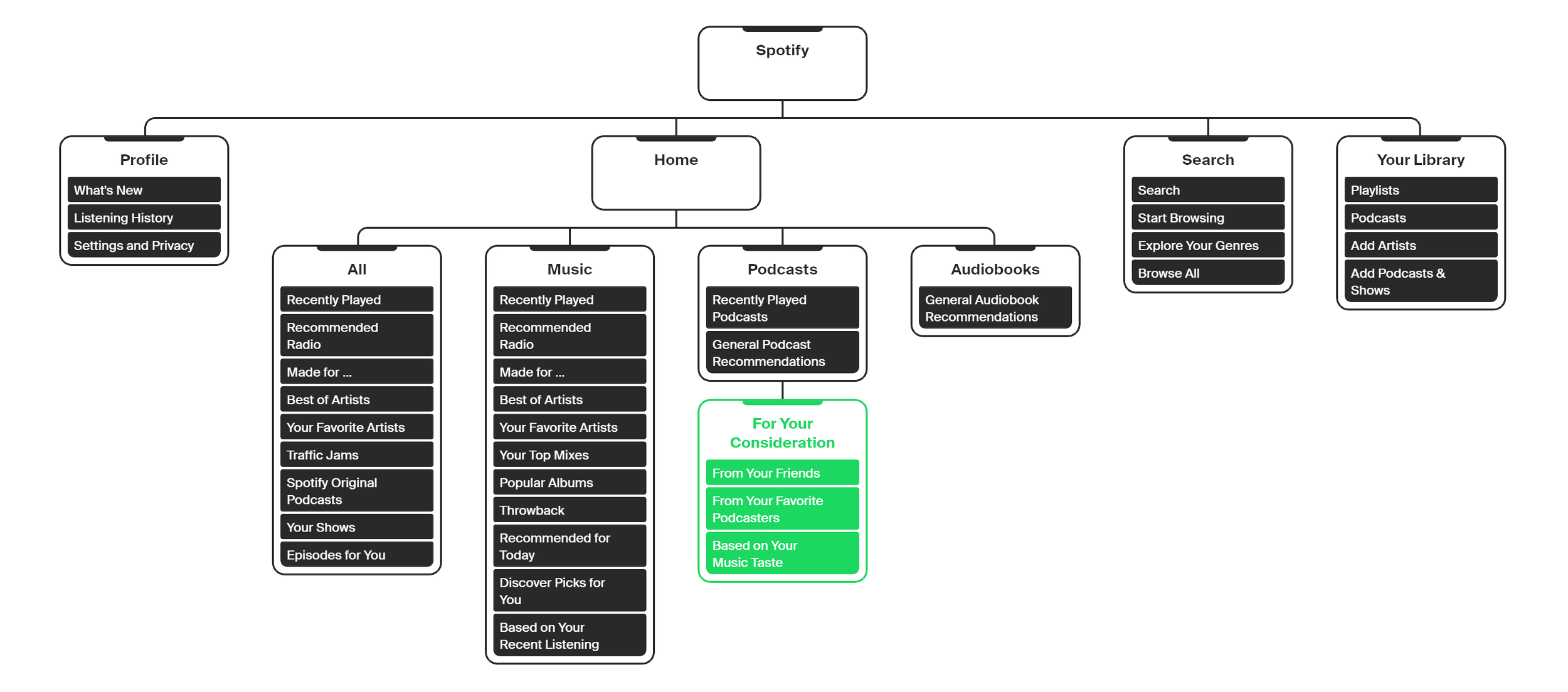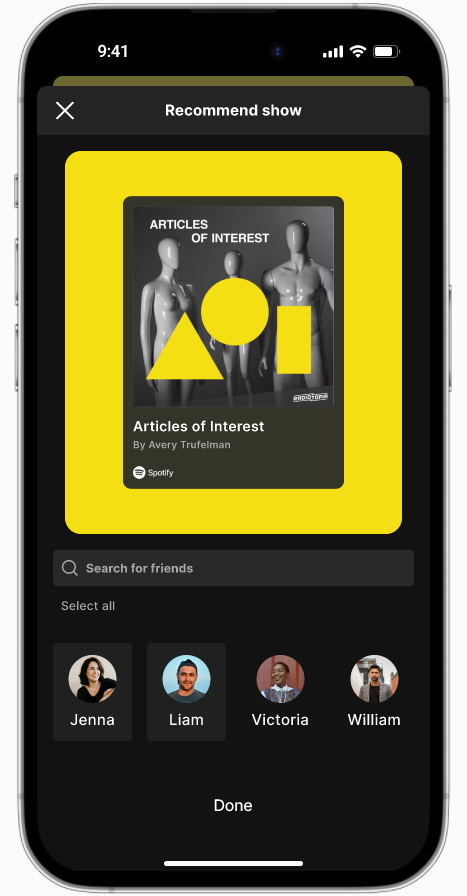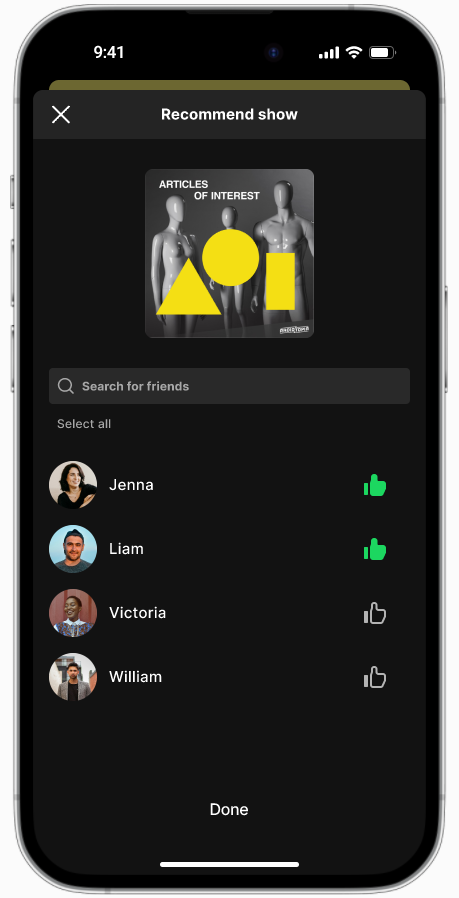
Spotify
Spotify
Feature that bolsters podcast traffic by enhancing recommendations
Feature that bolsters podcast traffic by enhancing recommendations
More than Just a Music App
Spotify has been making efforts to rebrand as a listening app and not just an app for music for a number of years now. There is a disconnect between the direction the company is going in and the existing perception of the app by the general population. Many people, both users of Spotify and users of their competitors, see Spotify as “a music app that also has podcasts”. This feature improves upon the existing framework of recommendations in an effort to convert more users into Spotify podcast listeners so that Spotify solidifies its place in the market as a listening app.
67% of U.S. podcast listeners say they have recommended a podcast to someone else and 60% of podcast listeners say they have listened to a podcast recommended by friends or family (Shearer et al., 2023).
In order to increase their share of podcast listeners, Spotify must meet the demands of users of rival apps while also finding ways to encourage Spotify music listeners to explore Spotify podcasts. A common frustration for podcast listeners is how they receive recommendations. Users also struggle to utilize the limited organizational tools available within listening apps.
Spotify is an audio streaming service founded in 2006. It has over 600 million monthly active users and over 200 million paying subscribers. A report from early 2024 shows that around 40 million users regularly listen to podcasts. This represents about 7% of Spotify users. Spotify’s share of U.S. podcast listeners appears to be 25%.
How Spotify Can Stay on Top
Problems
Recommendations are too broad or inaccurate
Organizational tools are not very useful for podcasts
Proposed Solutions
Recommendations that are curated based on user’s listening experience
Additional organizational tools for podcasts, especially ones with a lot of content
Findings
Taking suggestions from an algorithm feels inorganic
Recommendations are based on broad categories
Podcast listening is affected by the user’s environment
The “Library” does not provide adequate organizational tools
Users spend a lot of time searching or scrolling for podcasts
Research
Methods
To better understand Spotify’s podcasting features in relation to the features of other podcast apps on the market, I conducted a competitive analysis. The competitive analysis confirmed my suspicion that Spotify did not have any standout features when compared to other platforms. After completing the analysis, I interviewed users of Spotify’s largest competitor, Apple Podcasts. These interviews revealed the gaps in the podcasting space that Spotify would need to fill to beat out competitors.
Adding Context to User Frustrations
From conducting user interviews, I learned more about the growing presence of podcasts in people’s lives. I chose to focus this persona on the overarching issue that comes with a fast-growing sector like podcasts, which is that people have too much to choose from and too little time to choose. People have very limited free time these days, so it is important for them to be able to quickly transition from an old podcast to a new one. This way, they feel like their podcast listening experience is progressing smoothly.
Finding a Place for the Feature
Recreating the existing structure of the Spotify app in the form of a sitemap allowed me to assess where my feature should be housed. I came to the logical conclusion that a feature based around podcast recommendations should be placed within the podcast page, which can be accessed from the homepage.
Simplifying Flows
Setting up user flows reminded me that, while providing accurate recommendations is the ultimate goal, the process of selecting a recommendation should be simple and straightforward. The process of recommending a podcast follows this trend.
Integrating Spotify’s Design System
Drawing up wireframes helped me tailor my ideas to fit into the Spotify design system. It also assisted me in figuring out if certain screens were unnecessary. Perhaps the most important aspect of wireframing was that I was able to see my ideas for types of recommendations in a more concrete way.
Discovering Pain Points
I converted my wireframes from low-fidelity to high-fidelity by creating components that followed Spotify’s UI guidelines. After completing this I moved on to user testing. User testing proved to be very successful, with every user having little to no difficulty completing the task of adding seasons from new podcasts. Users also successfully completed the task of recommending a podcast, but they had one reservation. The screen for recommending a podcast to friends was a bit confusing for users as they pointed out how similar it was to the screen for sharing a podcast. I simplified this screen’s design and made it distinct from other pages by utilizing my new recommend icon.
The original recommend show screen.
The updated recommend show screen.
Achieving Results
Simplifying the “Recommend Show” screen made users more comfortable with the process of recommending a podcast and helped them understand that this recommendation would occur within the app itself. Below is a demonstration of the tasks within the Spotify feature prototype.
Allowing users to recommend seasons or specific episodes
The ability to add multiple podcasts to a single playlist
These are some of the improvements that can push the new feature’s capabilities further. They are supported by findings from my competitive analysis and my research.
Opportunities for Development
Lessons Learned
I had to iterate the “For Your Consideration” component several times to make sure that it was simple and informative while still in harmony with the other components. I noticed that sometimes I get carried away with making things illustrative and I forget that features that are clear cut often provide the best user experience.
When ideating, I struggled to choose between addressing deficiencies in Spotify’s recommendations and their organizational tools. I was thinking rigidly and could not see how they were related. I understand now that when designing new features, it can be necessary to alter an app's existing structures.







